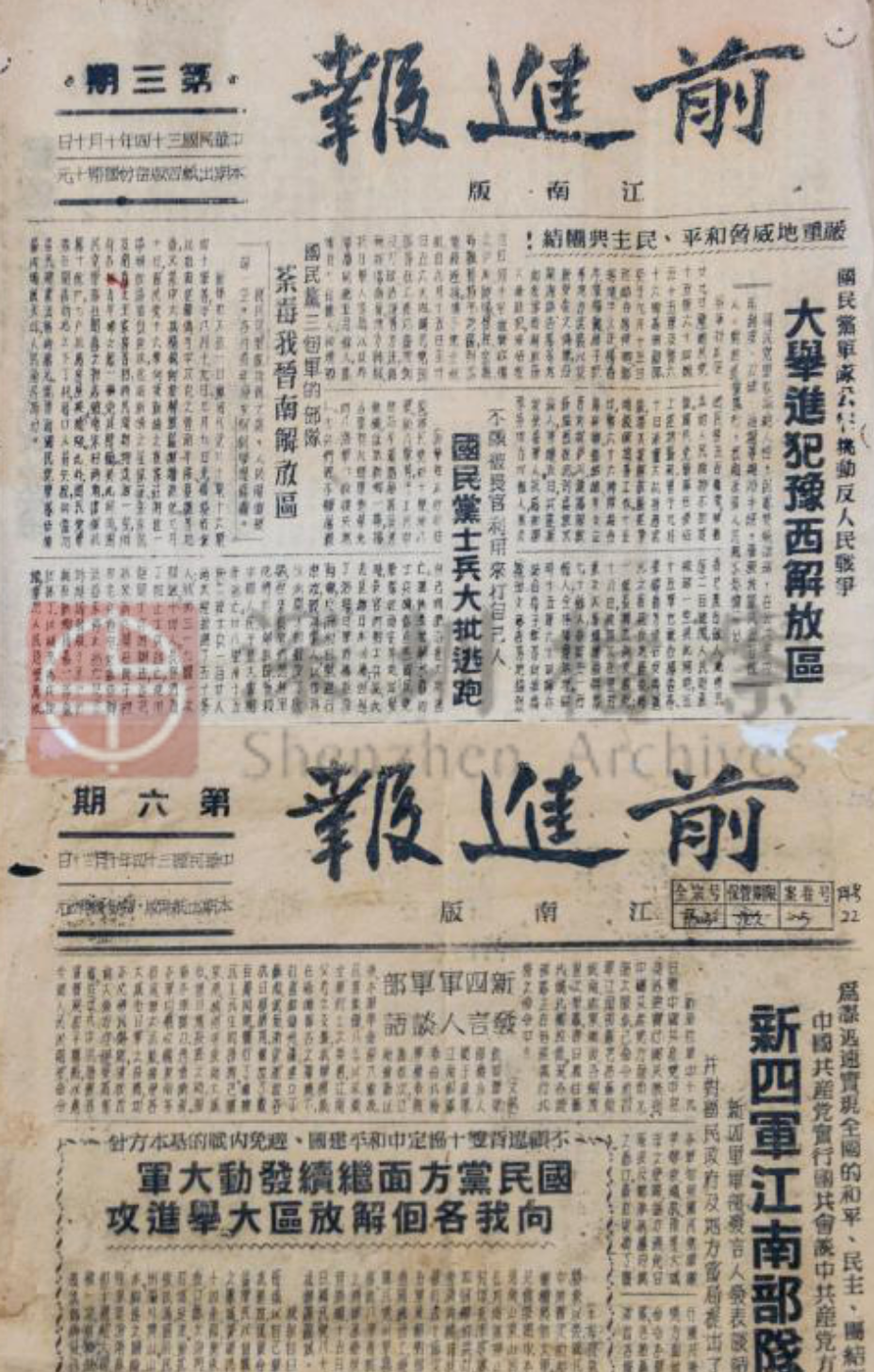
深圳市坪山区的石灰陂村是有着“革命年代媒体先驱”之称的《前进报》的诞生地。这份报纸的前身是《东江民报》,它用一串串文字、一篇篇报道,开辟了一个凝心聚力的言论阵地。
Shihuipi Village in Pingshan District was the birthplace of Qianjin News, a media pioneer in a time of revolution. Developed from Dongjiang People’s News, the newspaper was a battleground of speech that brought people together through words and reports.
1942年2月,《东江民报》创立,一周一期。邹韬奋为报头题字,并撰写了发刊词和社论——《惠博沦陷的教训》;茅盾为副刊《民声》题写刊名。在《东江民报》出版6期后,同年3月改名为《前进报》。1943年东江纵队成立后,《前进报》成为东江纵队机关报,由政治部直接领导,东江纵队领导人多次为报纸撰写指导性政策性文章。
In February 1942, Dongjiang People’s News was founded as a weekly publication. Zou Taofen, a renowned journalist, media entrepreneur, and political activist, inscribed the title for the newspaper and wrote the foreword, which was also a piece of opinion, for the newspaper. Mao Dun, a well-known writer, gave the newspaper’s supplement the title of People’s Voice. After six issues were published, the title of the newspaper was changed in March to Qianjin News. After the founding of the Dongjiang Guerrilla Column, the newspaper became the official organ of the column.
在艰苦而复杂的抗战环境里,《前进报》一诞生就处在日、伪、顽军的夹击中,但始终没有放弃传递革命之声的职责。报社没有固定的地址,茅棚、山洞、密林就是出版场所。在雨季,为了顺利出报,曾在敌人的炮台山脚下搭过小屋。战友们以军毡为帐篷,把藤篮工具箱作为桌子,用香火把蜡纸熔化粘成一张大报。每张蜡纸平均印四五千张,这一纪录最高时达到七千张,创造了一个奇迹。
In spite of wartime hardships, the staff of the newspaper never gave up the responsibility to convey the voice of revolution. Without an office, they worked in shelters, caves and forests. In rainy seasons, they even built a cabin at the foot of a mountain occupied by the enemy just to ensure the publication of the newspaper. With tents made of blankets, they used rattan baskets and cabinets as desks for work and used melted pieces of wax paper for printing the newspaper pages. Each piece of wax paper could be printed into four or five thousand pieces of newspaper. They even created a miracle by printing seven pages of newspaper with just one piece of wax paper.
作为宣传工具,《前进报》在基层连队中构建了通讯员网络,新闻消息鲜活丰富,发挥了启发群众、激励革命队伍、打击敌人的作用。《前进报》常常综合汇编各类消息,新闻虽“多”却“短”,排版灵活、印刷清晰,内容具有地方特点,文字简练活泼。《民声》副刊曾运用当地方言刊登一些东江地区的客家山歌和“讲古”(即新故事)。
As a tool to promote the revolution, the newspaper also set up a correspondents’ network among grassroots soldiers. The news stories were diversified and written vividly, which helped to inspire the general public and the revolutionary forces. The newspaper featured a variety of short stories written in simple, vivid language and arranged in a reader-friendly layout. Readers could also find local folk songs and new renderings of folk stories in the Dongjiang area in the supplement.
不仅如此,《前进报》还配合斗争形势创作了连环画和漫画,比如第62期,刊登了美国航空队中尉敦纳尔·克尔自己画的关于他飞机失事,被东江纵队“小鬼”营救的漫画,妙趣横生。因为读得快、读得多,还读得懂,《前进报》受到了广大指战员、战士和人民群众的喜爱。
In addition, cartoons and caricatures were also found in the newspaper. For example, in the 62nd issue, a cartoon created by Lieutenant Donald W. Kerr of the American Volunteer Group was published. The cartoon told the story about how Kerr was saved by a boy of the Dongjiang Column after his aircraft was hit. Because of its friendliness to readers, the newspaper was popular not only among commanders and soldiers, but also among the general public.

《前进报》
A front page from Qianjin News.
1943年底,敌伪占领广九线,开展“万人扫荡”。《前进报》配合宣传,激励并团结了战士和群众,帮助部队粉碎了敌伪扫荡、清乡、蚕食、抢粮等行动,保存和壮大了革命队伍。1945年,在党的“七大”胜利闭幕后,报社赶排了解放日报的社论《团结的大会,胜利的大会》等七大文献,并印刷成小册子,向华南各抗日游击队散发。
At the end of 1943, the Japanese forces occupied the Canton-Kowloon Railway. The works of Qianjin News were a great inspiration for the soldiers and the people and facilitated the victory over multiple Japanese operations. After the seventh National Congress of the CPC in 1945, the newspaper published seven major articles about the congress, compiled them into brochures, and distributed them to the guerrilla forces in South China.
直至1946年6月底,《前进报》停刊,共发行100期,发行范围遍及东江、珠江、粤中、粤北、西江、韩江和南路等各游击区和部队,在华南敌后产生了广泛而深远的影响。
In late June 1946, the newspaper stopped publication after its 100th issue. With its distribution in different areas including the Dongjiang River area, the Pearl River area, Central Guangdong, North Guangdong, the Xijiang River area, and the Hanjiang River area, the newspaper had a wide and profound influence on the areas behind the enemy’s lines in South China.
今日互动:《前进报》是东江纵队机关报。您是否了解东江纵队的故事呢?欢迎留言分享,小i将在留言中选取幸运儿送出小礼物。
Today's topic: Do you have any stories about the Dongjiang Guerrilla Column? Feel free to leave your comments and lucky people will receive gifts.

来源:深圳市档案馆、i深圳
Source: Shenzhen Archives, iShenzhen
编译:深圳政府在线、Shenzhen Daily、GDToday
Transedited by: Shenzhen Government Online, Shenzhen Daily, GDToday